Soft and hearty, these oatmeal molasses dinner rolls are irresistibly chewy, lightly sweet, and oh-so-buttery with a warm, nostalgic flavor. Whether you’re a bread beginner or a seasoned yeast baker, this recipe walks you through every step with simple techniques, make-ahead options, and plenty of foolproof guidance so you can serve soft, rustic rolls any night of the week.
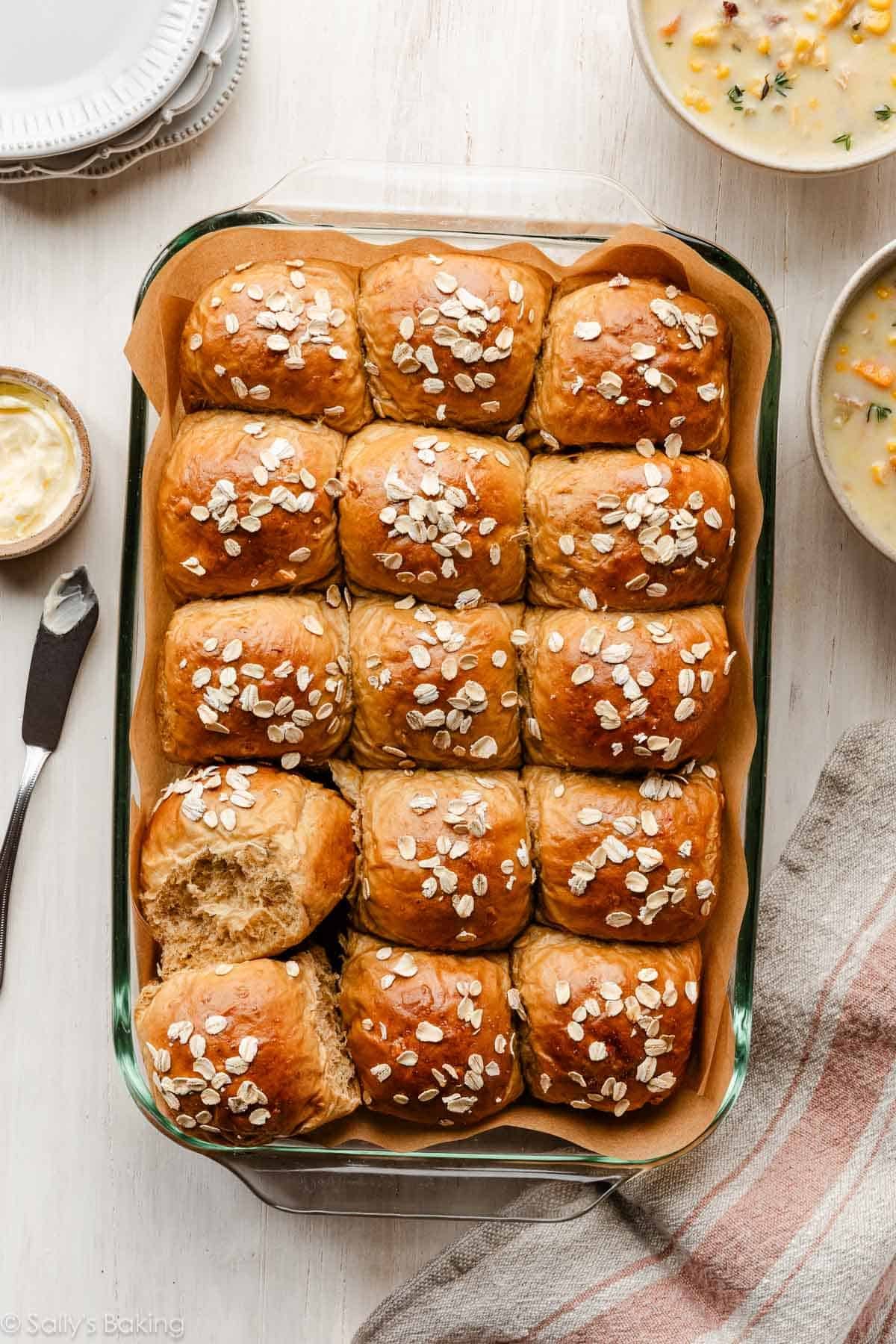
This recipe is brought to you in partnership with Red Star Yeast.
These oatmeal molasses rolls are wholesome and gently sweet; the kind you tear open while they’re still steaming, swipe with butter, and immediately reach for a second! I have them pictured above with chicken and corn soup, one of our favorite slow cooker dinners, and the whole meal felt like pure comfort!
Why You’ll Love These Rustic Dinner Rolls
- Soft, tender, and slightly chewy (thanks to the oats!)
- Homey molasses flavor, but not overly sweet
- Whole pan of rolls bakes in less than 30 minutes
- Egg free if you skip the egg wash on top
- Make-ahead options and freezing instructions
- Perfect with soups, stews, Thanksgiving dinner, Tuesday night… anything!
- Delicious served warm with homemade honey butter or cinnamon butter
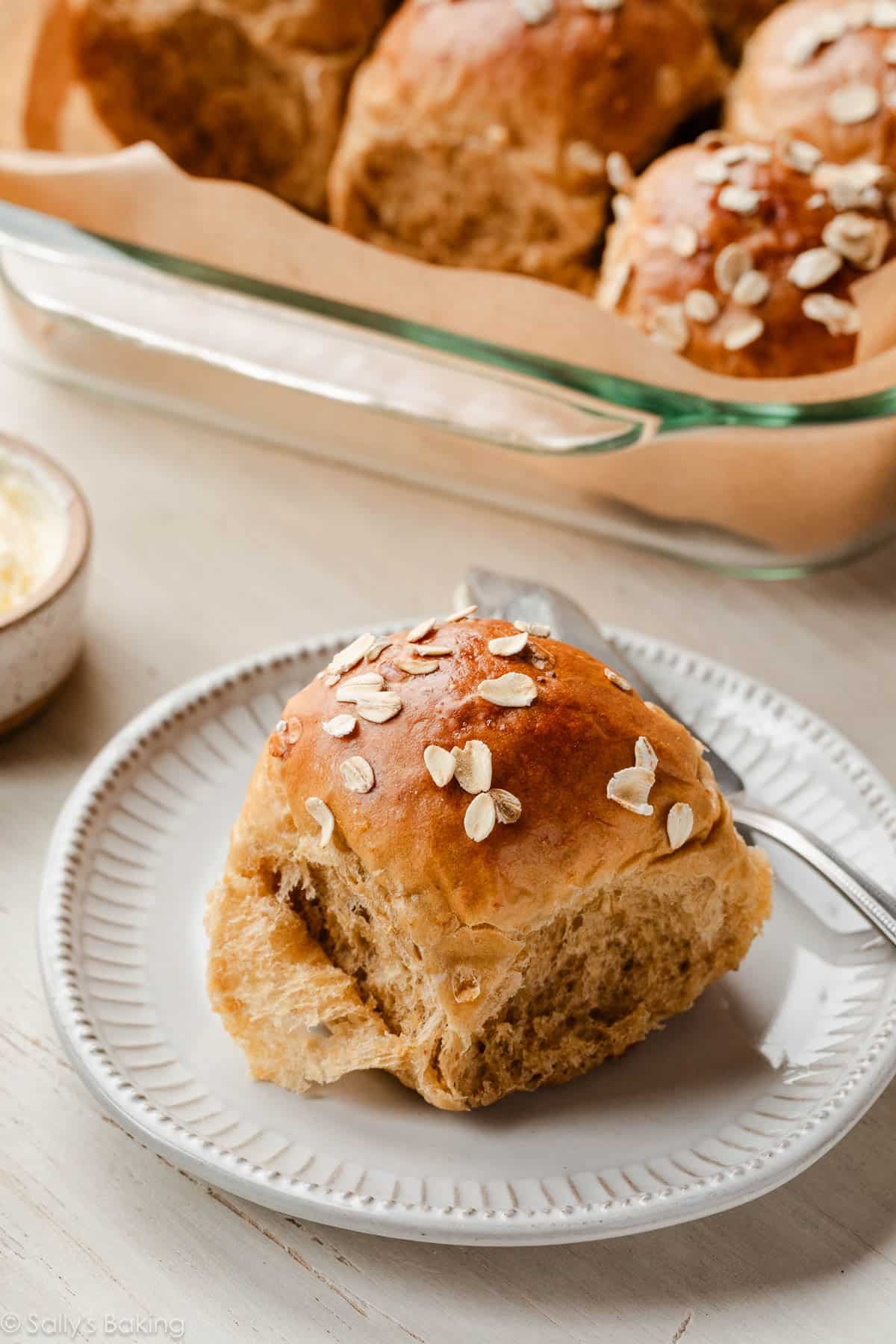
Ingredients You Need & Why
- Water + Milk: Water helps activate the yeast for a strong rise, while milk adds richness. Nondairy or low-fat milks work too, but whole milk produces phenomenal flavor and texture.
- Yeast: You can use active dry yeast or instant yeast. If using active dry yeast, the rise times will be a little longer. I recommend Platinum Yeast from Red Star, which is an instant yeast blended with natural dough improvers.
- Brown Sugar: Sugar feeds the yeast, increases its activity, and tenderizes the dough.
- Molasses: Choose a dark, unsulphured molasses for the best flavor, and avoid blackstrap molasses. It’s too intense for this dough and makes the rolls taste bitter.
- Butter: Butter promises a flavorful and soft dinner roll.
- Oats: Old-fashioned whole rolled oats are best here.
- Salt: You can’t make flavorful bread without salt!
- Flour: I recommend bread flour for this recipe. All-purpose flour is convenient for most, but bread flour produces chewier dinner rolls. There are no other changes to the recipe if you use all-purpose flour.
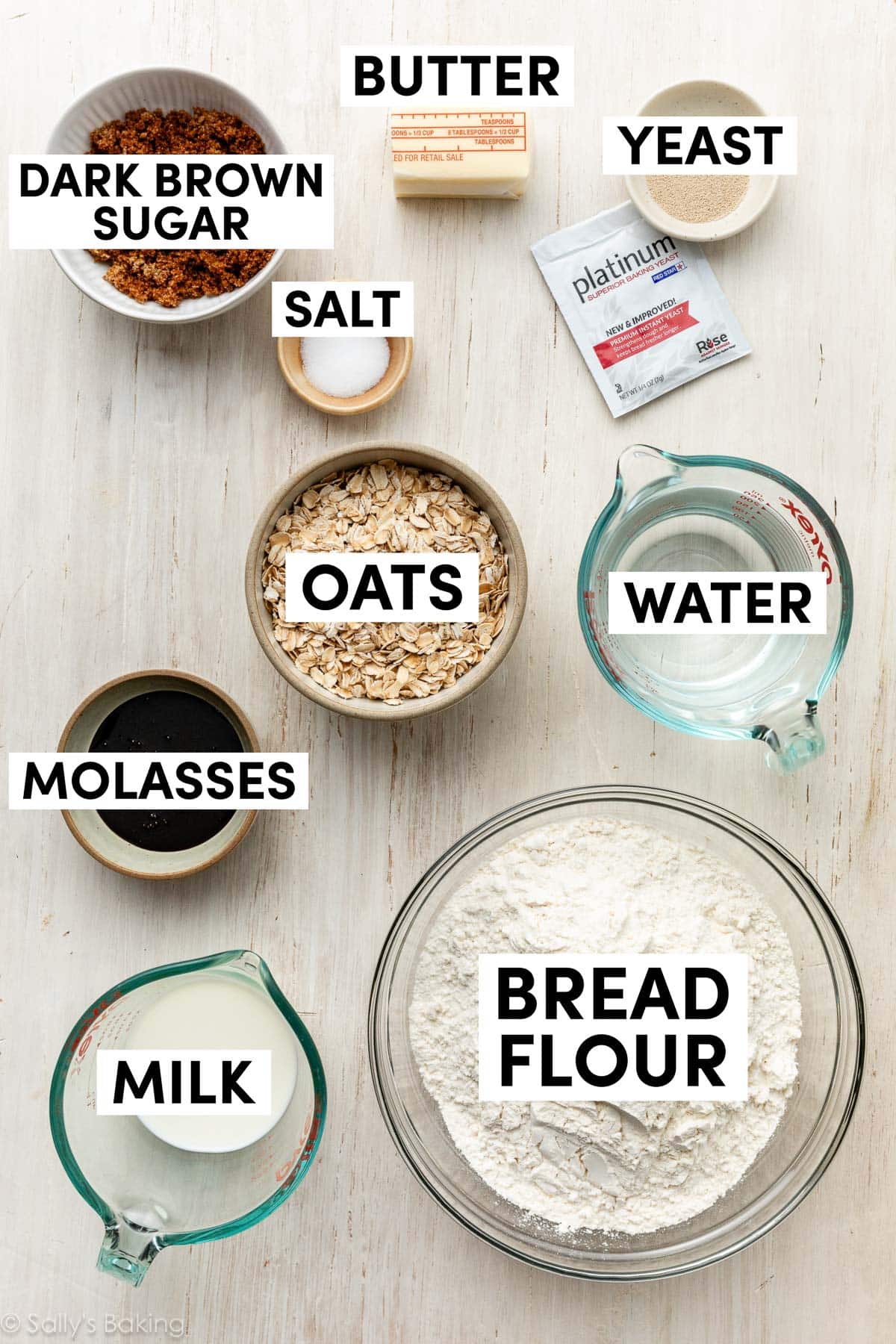
Yeast Bread Success Tips
If you’re a bread beginner, read this blog post to learn more about the yeast rolls recipe, including how to prep the rolls ahead of time. You can also reference my Baking with Yeast Guide for answers to common yeast FAQs.
In Pictures: How to Make Oatmeal Molasses Rolls
The first step is to proof your yeast, a step I take even if I’m using instant yeast. All you do is mix the yeast with the warm liquid (water + milk), and a little sugar (we’re using brown sugar today). Cover and let it sit for 5–10 minutes until foamy and frothy on top. This proves your yeast is active and ready to get to work:
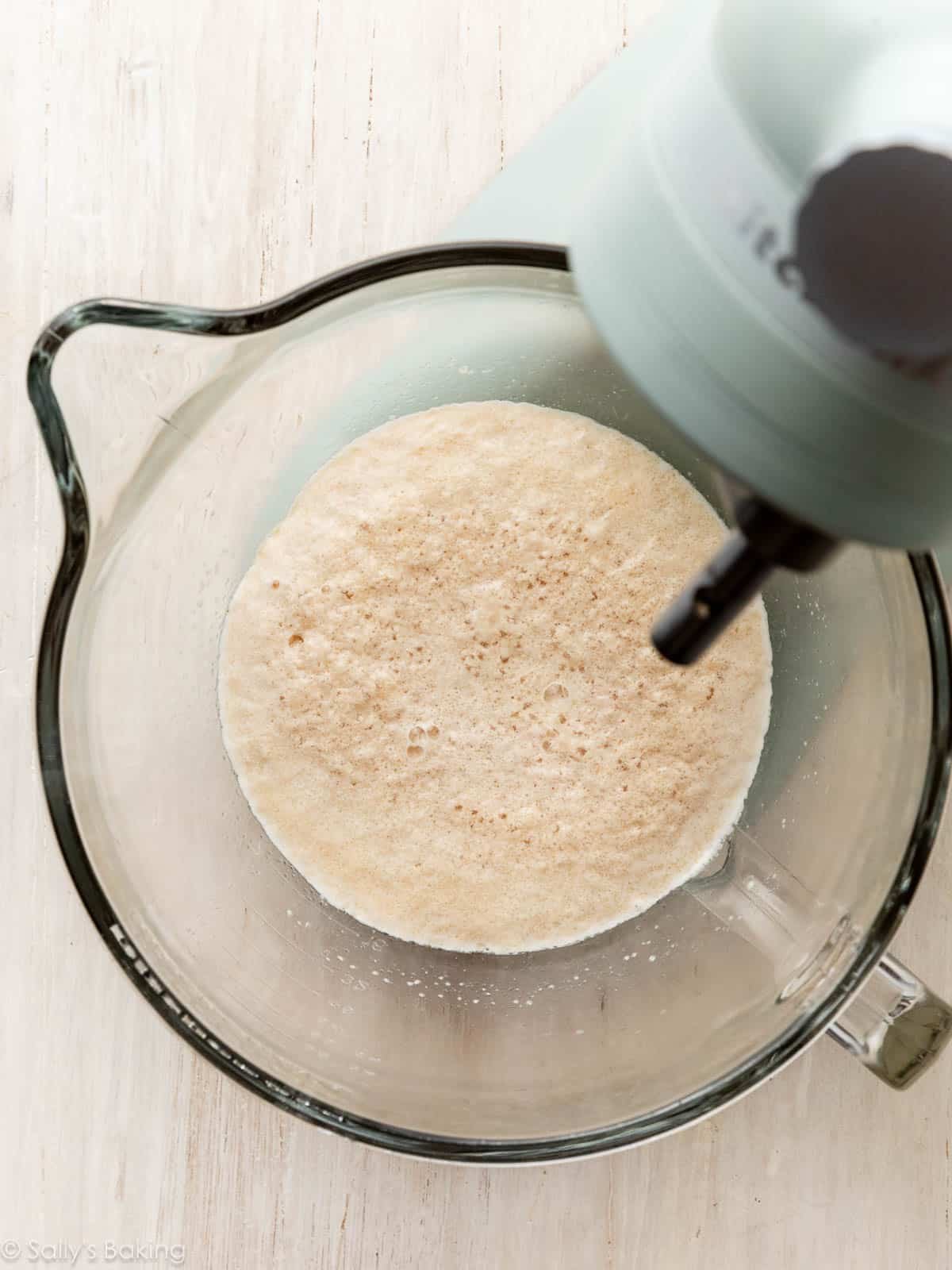
Then, add the rest of the ingredients to form a soft dough. Add enough flour for the dough to come together into a kneadable mass; it should be pulling away from the sides of the stand mixer’s bowl. (You can make this dough even if you do not have a stand mixer, see step 1 below.)
The dough should feel slightly tacky, but not overly sticky. On a lightly floured work surface, using the heels of your hands, stretch and fold the dough with gentle motion. If you’d like a visual of how to knead the dough by hand, you can watch the full video tutorial in my post on how to knead dough.
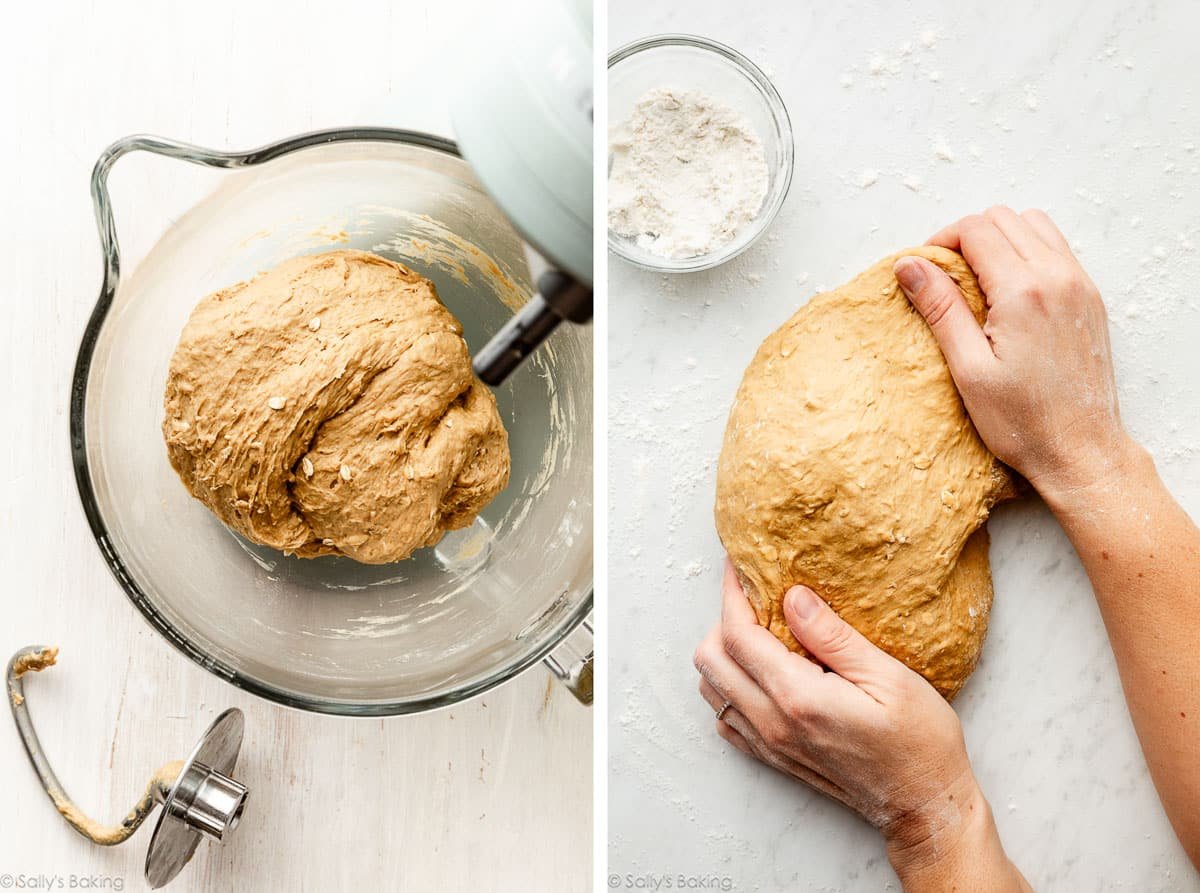
Once your dough has been kneaded for long enough, let it rise:

Shape the Rolls
Punch down the risen dough to release the air, and then divide the dough into 15 pieces, roughly equal in size (about 65–70g each—they don’t have to be exact). A kitchen scale is really handy for dividing the dough into evenly sized rolls.
Take a piece and stretch the top of the dough while pinching and sealing the bottom. Make sure the rolls are smooth on top and sealed on the bottom. This is the same way we shape the balls for brioche and sweet potato dinner rolls.
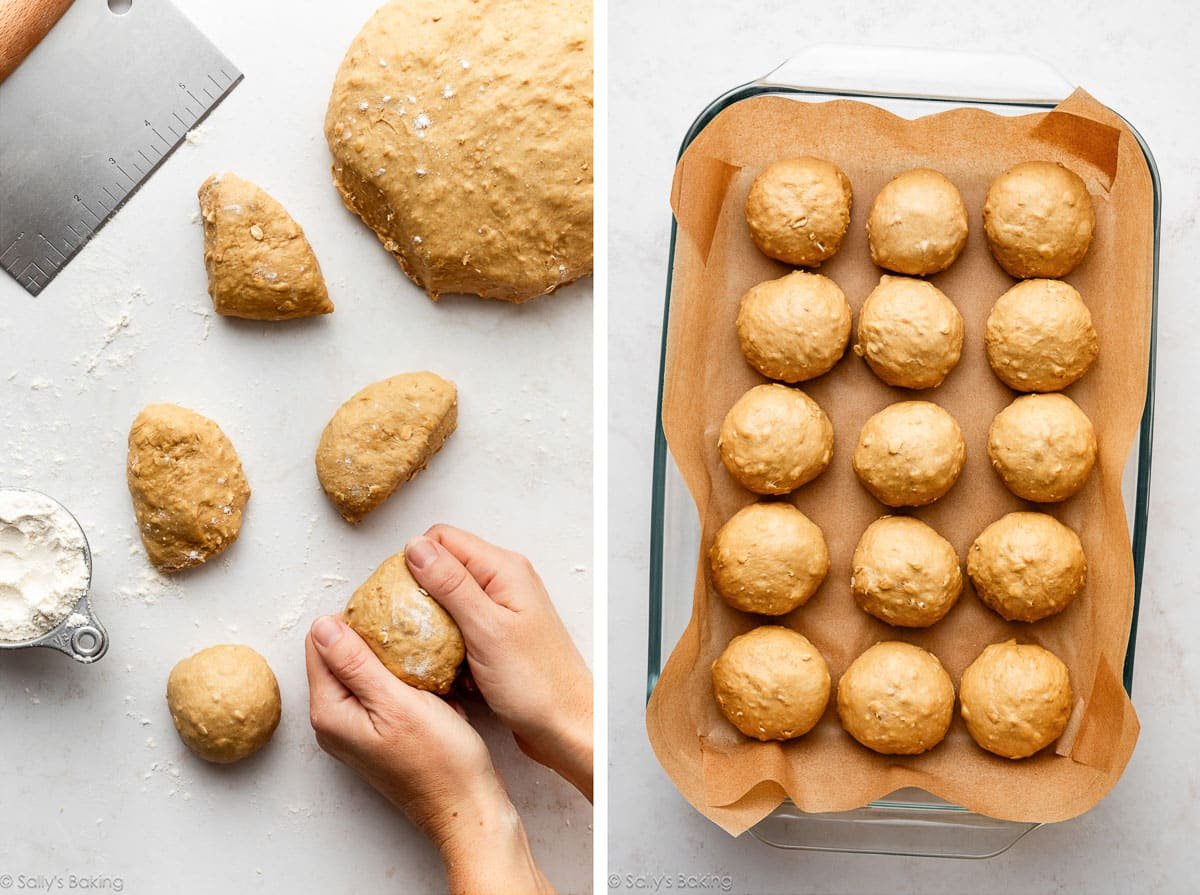
Arrange them in a greased baking pan. A 9×13-inch baking pan is ideal for these oatmeal molasses dinner rolls, but you can bake them on a lined baking sheet or in two 9-inch round or square pans instead.
Loosely cover, and let the shaped rolls rise before baking. Brush with an egg white mixed with a little water and sprinkle with oats right before putting them in the oven. The topping is optional!
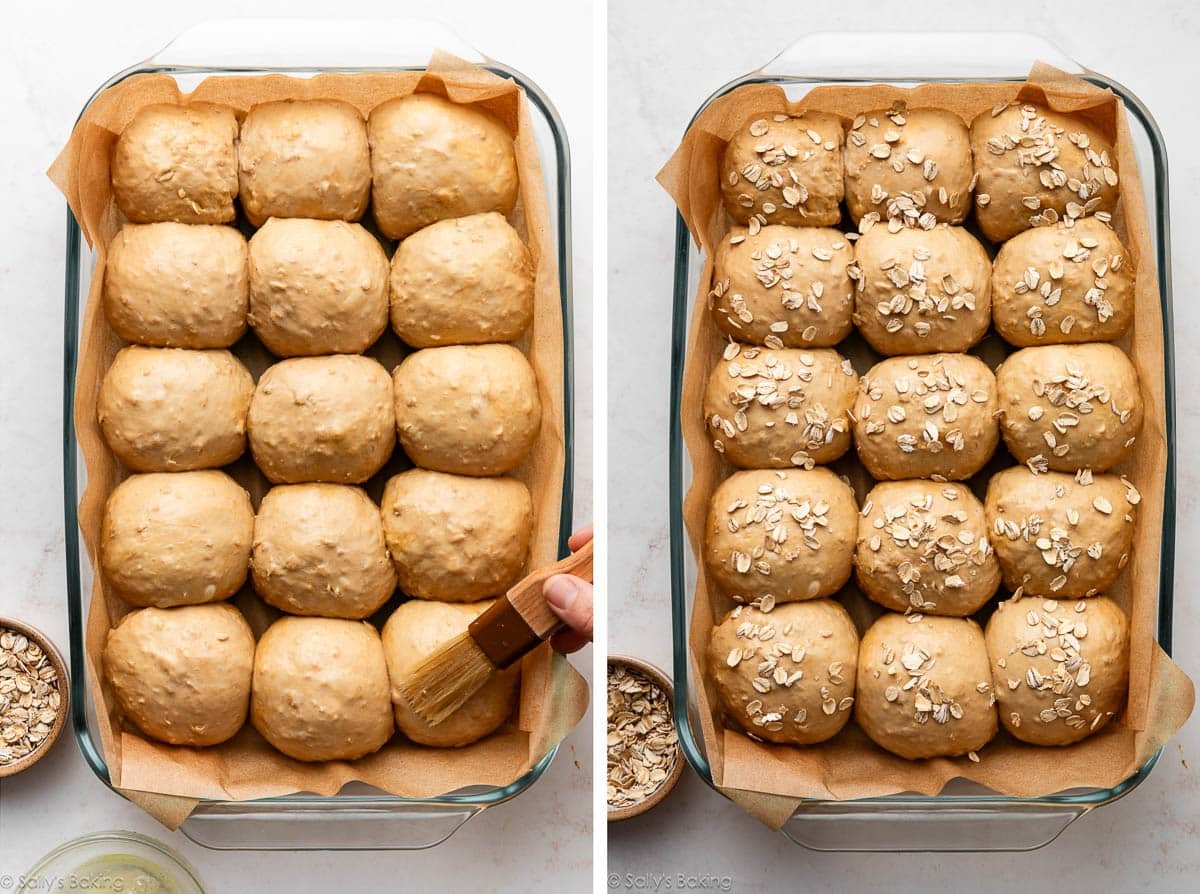
They bake in just under half an hour. If you want to take them to the next level, serve these oatmeal molasses dinner rolls with homemade cinnamon butter or honey butter.
Make-Ahead Tips
- Slow the rise: Refrigerate shaped rolls for up to about 15 hours. At least 3 hours before you need them the next day, remove the rolls from the refrigerator and allow to rise on the counter for about 1–2 hours before baking. Add a few extra minutes to the bake time.
- Freeze baked rolls: Cool completely, wrap tightly, and freeze for up to 3 months.
- Freeze dough: Freeze after shaping; thaw overnight in the refrigerator, let rise, then bake as directed.
These make-ahead options are especially helpful if you want fresh-baked rolls for a holiday meal.

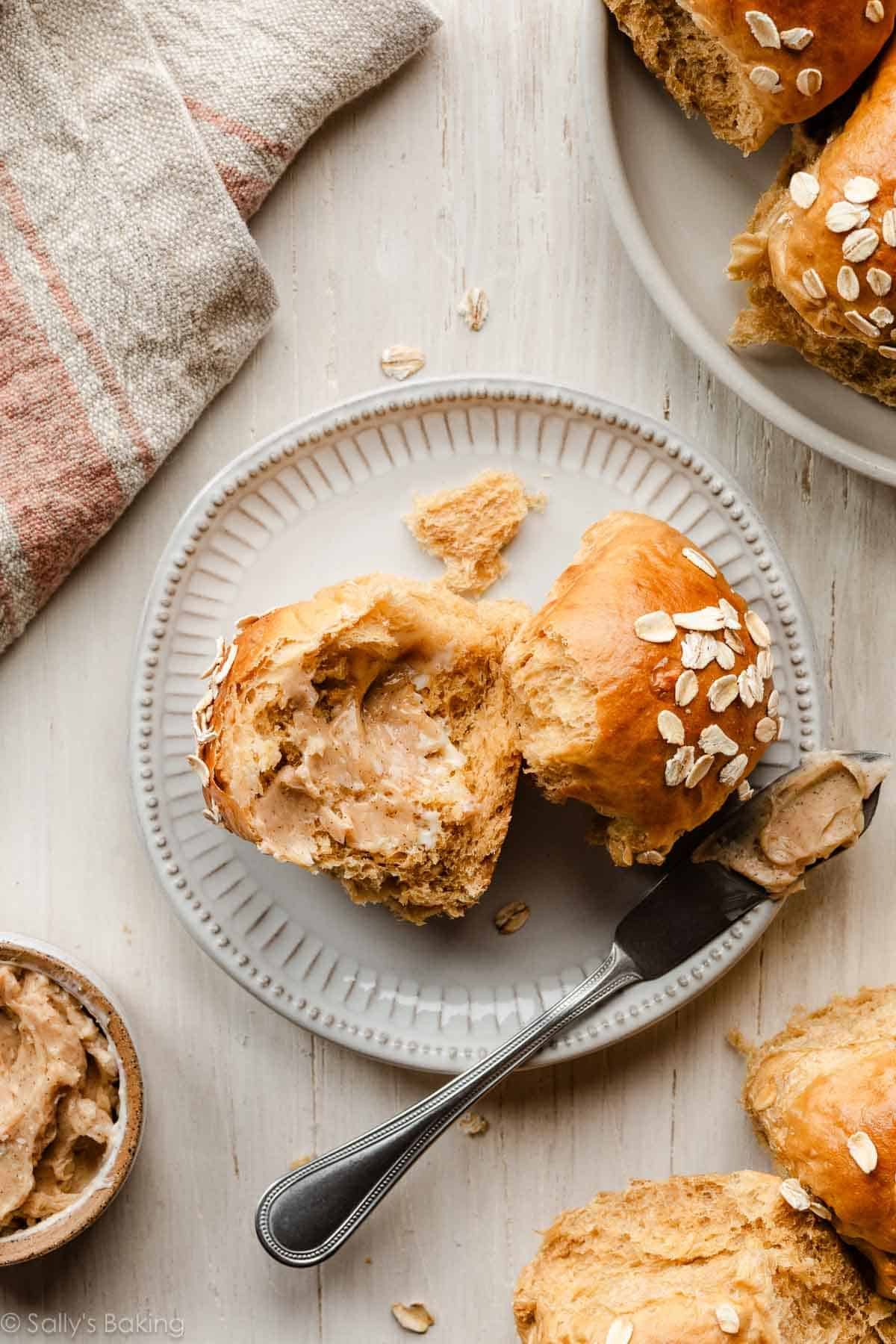

Oatmeal Molasses Dinner Rolls
- Prep Time: 3 hours, 25 minutes
- Cook Time: 26 minutes
- Total Time: 3 hours, 50 minutes
- Yield: 15 rolls
- Category: Dinner
- Method: Baking
- Cuisine: American
Description
These soft, hearty oatmeal molasses dinner rolls are wholesome, gently sweet, and perfect for any comforting meal. The recipe walks you through each step and includes make-ahead and freezing instructions in the Notes below.
Ingredients
- 1 cup (240g/ml) water, warmed to about 110°F (43°C)
- 1/3 cup (80g/ml) whole milk, warmed to about 110°F (43°C)
- 1 Tablespoon (9g) Platinum Yeast from Red Star instant yeast
- 3 Tablespoons light or dark brown sugar, divided
- 3 Tablespoons (64g) molasses
- 4 Tablespoons (56g) unsalted butter, softened to room temperature and cut into 4 pieces
- 1 cup (85g) old-fashioned whole rolled oats, plus more for topping the rolls
- 3 and 1/2 cups (455g) bread flour (spooned & leveled), plus more as needed
- 1 teaspoon salt
- egg wash: 1 egg white beaten with 1 teaspoon of water
Instructions
- Prepare the dough: Whisk the warm water, milk, yeast, and 1 Tablespoon of the brown sugar together in the bowl of your stand mixer. Cover and allow to sit for 5–10 minutes, until foamy and frothy on top. *If you do not own a stand mixer, you can do this in a large mixing bowl and in the next step, mix the dough together with a large wooden spoon/silicone spatula. It will take a bit of arm muscle. A hand mixer works, but the sticky dough repeatedly gets stuck in the beaters. Mixing by hand with a wooden spoon or silicone spatula is a better choice.*
- Add the remaining brown sugar (2 Tablespoons), the molasses, butter, oats, salt, and 1 cup of bread flour. With a dough hook or paddle attachment, mix/beat on low speed for 1 minute, stop and scrape down the sides of the bowl with a silicone spatula, then add the remaining 2 and 1/2 cups of flour. Beat on medium speed until the dough comes together and pulls away from the sides of the bowl, about 2 minutes. If the dough seems too wet to a point where kneading (next step) would be impossible, beat in more flour 1 Tablespoon at a time until you have a workable dough, similar to the photos above. Dough should be soft and a little sticky, but still manageable to knead with lightly floured hands.
- Knead the dough: Keep the dough in the mixer and beat for an additional 5-8 minutes, or knead by hand on a lightly floured surface for 5-8 minutes. (If you’re new to bread-baking, my How to Knead Dough video tutorial can help here.) If the dough becomes too sticky during the kneading process, sprinkle 1 teaspoon of flour at a time on the dough or on the work surface/in the bowl to make a soft, slightly tacky dough. Do not add more flour than you need because you do not want a dry dough. After kneading, the dough should still feel a little soft. Poke it with your finger—if it slowly bounces back, your dough is ready to rise.
- 1st Rise: Lightly grease a large bowl with oil or nonstick spray. Place the dough in the bowl, turning it to coat all sides in the oil. Cover the bowl with plastic wrap or a clean kitchen towel. Allow the dough to rise in a relatively warm environment for 1.5–2 hours or until double in size. (I always let it rise on the counter. Takes about 2 hours. For a tiny reduction in rise time, see my answer to Where Should Dough Rise? in my Baking with Yeast Guide.)
- Grease a 9×13-inch baking pan or two 9-inch square or round baking pans, or line with parchment paper. You can also bake the rolls in a cast-iron skillet or on a lined baking sheet.
- Shape the rolls: When the dough is ready, punch it down to release the air. Divide the dough into 15 equal pieces, about 68–70g each. A kitchen scale is helpful for this step. Shape each piece into a smooth ball. Here is what I usually do: take a piece of dough and stretch the top while pinching and sealing the bottom. Make sure the rolls are smooth on top and sealed on the bottom. Arrange in prepared baking pan.
- 2nd Rise: Cover shaped rolls with plastic wrap or a clean kitchen towel. Allow to rise until puffy, about 30–60 minutes.
- Adjust oven rack to a lower position and preheat oven to 350°F (177°C). (It’s best to bake the rolls towards the bottom of the oven so the tops don’t burn.)
- Bake the rolls: Gently brush the tops of the risen rolls with egg wash, and lightly sprinkle each with oats. Bake for 26–27 minutes or until golden brown on top, rotating the pan halfway through. If you notice the tops browning too quickly, loosely cover the pan with aluminum foil. To ensure they’re fully baked, check the internal temperature with an instant-read thermometer; it should read 190°F (88°C).
- Allow rolls to cool for a few minutes before serving. Cover leftover rolls tightly and store at room temperature for 2–3 days or in the refrigerator for up to 1 week.
Notes
- Overnight Instructions: Prepare the recipe through step 6. Cover the shaped rolls tightly and refrigerate for up to about 15 hours. At least 3 hours before you need them the next day, remove the rolls from the refrigerator, keep covered, and allow to rise on the counter for about 1–2 hours before baking. Alternatively, you can let the dough have its 1st rise in the refrigerator overnight. Cover the dough tightly and place in the refrigerator for up to about 15 hours. Remove from the refrigerator and allow the dough to fully rise for 2 more hours at room temperature. Continue with step 5.
- Freezing Instructions: Prepare recipe through step 6. Place shaped rolls in a greased baking pan, cover tightly, and freeze for up to 3 months. Once frozen, the dough balls won’t stick together anymore and you can place them in a freezer bag if needed. On the day you serve them, arrange the dough balls in a greased baking pan, cover tightly, then let them thaw and rise for about 4–5 hours. Bake as directed. You can also freeze the baked dinner rolls. Allow them to cool completely, then freeze for up to 3 months. Thaw in the refrigerator or at room temperature, then reheat as desired. If reheating the whole pan, lightly cover with foil and reheat in a 300°F (149°C) oven for about 10 minutes or until warm.
- Special Tools (affiliate links): Electric Stand Mixer or Glass Mixing Bowl and Wooden Spoon / Spatula | 9×13-inch Baking Pan | Bench Scraper | Kitchen Scale | Pastry Brush
- Baking Pan: I prefer baking the rolls in a glass 9×13 inch baking pan because I find they brown a little too quickly in metal. As long as you bake the rolls on a lower oven rack and keep your eye on them, any pan is great.
- Yeast: Platinum Yeast from Red Star is an instant yeast. Any instant yeast works. You can use a 1:1 substitution of active dry yeast instead with no changes to the recipe. Rise times will be slightly longer if using active dry yeast. Reference my Baking with Yeast Guide for answers to common yeast FAQs.
- Flour: You can use bread flour or all-purpose flour. All-purpose flour is convenient for most, but bread flour produces chewier dinner rolls. The rolls are still soft and fluffy no matter which you use. Either flour is fine and there are no other changes to the recipe if you use one or the other.
- Make It An Egg-Free Recipe: Omit the egg wash and oat topping, and instead brush the tops of the rolls with melted butter after baking.
Loosely adapted from our Soft Dinner Rolls and King Arthur Baking’s honey oatmeal rolls.

















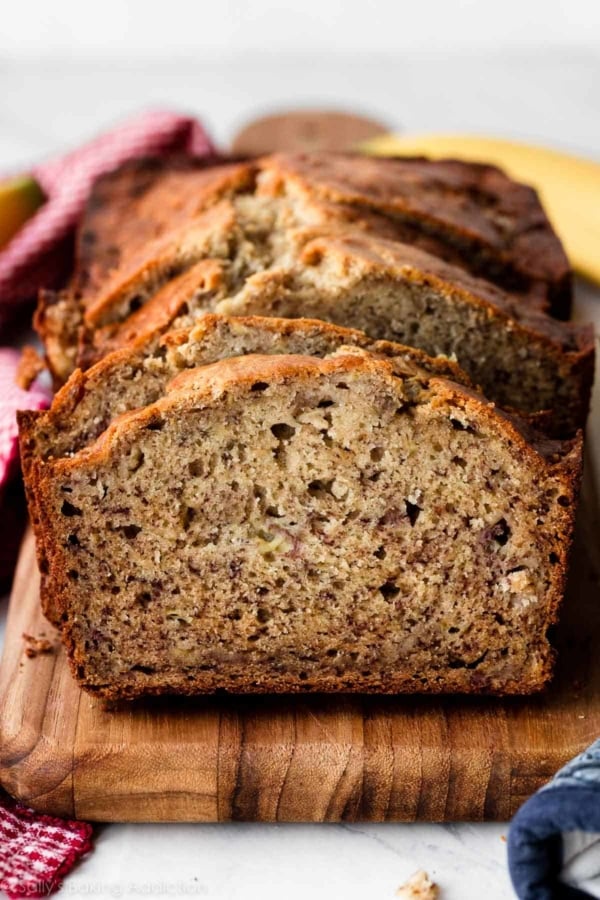

Reader Comments and Reviews
These are delicious and just different enough to add variety to a bread basket. Definitely adding them into the rotation!
My 16 yr old granddaugter has been making your soft roll recipe for holidays by herself for several years. This year she wanted to try some new recipes and she was excited to try the Molasses Oatmeal rolls. They and the cinnamon butter were outstanding. Everyone was impressed with the texture and flavor. This will undeniably be a regular recipe for our dinner table.
how could I make these into loaves instead of buns, is there anything I would need to do differently?
Hi Carrie, you can definitely turn these rolls into a loaf. After the 1st rise, shape it into a tight loaf (like this sandwich bread) and place it in a greased 9×5-inch pan. The main adjustment is the bake time: a loaf will need longer, usually around 35–38 minutes, and you’ll know it’s done when it’s deep golden and reaches about 190°F (88°C) in the center. Everything else stays the same, including the rise times.
Yep, these are amazing. Reminds me of Cheesecake Factory bread. Totally replaced my years long tradition of white rolls
These rolls were so good! They were a huge hit at our Thanksgiving table!
These rolls are delicious! I usually don’t tell the “molasses” part until my guests start raving over them. They will be served for thanksgiving!
Holyyyy cow. I’ve only ever made plain bagels, so when I saw the email with MOLASSES & OATS, I HADDD to make it. These are amazing!!!! I want to make them again!!! Sally’s done it again!
I made these and they are very tasty. Super soft too. I did notice a discrepancy between the oat measurement. 1 cup of oats is actually 113g. For this recipe do I go by volume or weight? I weighed all the other ingredients.
Hi Anna! Weight is always most accurate. Oats should be fluffed, spooned, and leveled when measuring. You can read more about measuring baking ingredients here!
These are perfect! I saved this recipe for a few weeks and decided to make them alongside my family stew, and I was curious if my kids would like them. Well, they’re gone. Guess what I’m making tomorrow morning?
This were delicious! I made the cinnamon butter and added a little more honey! They will be going to Thanksgiving dinner!
Just got the recipe for Oatmeal Molasses dinner rolls and had to try them. I tested the recipe to make sure I had no issues since I want to make them for Thanksgiving. They are beyond perfection! I don’t own a stand mixer so I put everything in my bread machine to make the dough. And then followed through with recipe. Your recipes are amazing Sally. These came out perfect and can’t wait to serve them on Thanksgiving with cinnamon honey butter!!
Can you use GF bread flour in this recipe!
Hi Ellen, we haven’t tested it to know the results, but let us know if you do!
Can’t wait to try this! Reminds me of the Cheesecake Factory bread!
This recipe is similar to the “porridge bread” commonly found in Cape Breton Nova Scotia. I make the dough in my bread maker and bake install loaves or rolls. So delicious.
Thank you for all your wonderful recipes. I always know that a Sally’s baking addiction creation will be amazing!
these Oatmeal Molasses dinner rolls are definetly something id like to try.
Can I use half and half instead of whole milk? I always have half and half on hand but I rarely buy milk.
Hi Robyn, we fear that half-and-half would be too heavy here. It’s best to stick with whole milk if you can.
I can’t wait to try this bread! Every recipe I have made from you Sally, is always a huge hit! You are one of my go-to Food Bloggers!
Sally, these look so amazing! I want to make them right now. I absolutely cannot wait to make these. What a great joy to get this recipe in my inbox!
What are the odds. I just needed a brown bread recipe for some baked beans and was struggling to find a recipe that is like my grandmothers for Nova Scotia style brown bread, which this basically is. The only difference is that we typically also soak the oatmeal till soft separate from the yeast and then once thats soft and the yeast is proofed it all goes together. Next time we need brown bread I am trying this one!
The soaking sounds interesting. I think I might do that with this recipe. I would guess it would have been done if the texture was off with unsoaked oats.
Hi Terry, you can certainly try soaking the oats. We tested it with this recipe, and we actually didn’t love the texture as much. (Which is why we published it without that step!) You will need to add more liquid since the oats soak up a lot of moisture.
Made these today for thanksgiving dinner tomorrow. They turned out great. We ate several right away…you gotta make sure they’re good before you serve them to guests right! Much better than the cheesecake place that serves brown bread! Follow the recipe exactly. Will make again and again.
This has all the factors I’m looking for in a dinner roll!! I can not wait to try this recipe out, and I’m confident enough to leave a 5 star review in advance!
Do you have any recipes where you use sourdough discard?
Hi Sheriece, not at this time.
Hi. I’m not sure if this is “allowed” or “appropriate,” but check out Amy Bakes Bread. She has some discard dinner rolls recipes 🙂
Attempting this dough in my bread machine on a dough cycle because I’m feeling lazy – and then going to see if it bakes up well as a loaf! Will update accordingly lol
Curious if this turned out for you! I’m also a lazy bread maker. I would like to try this on the dough cycle too but still make rolls.